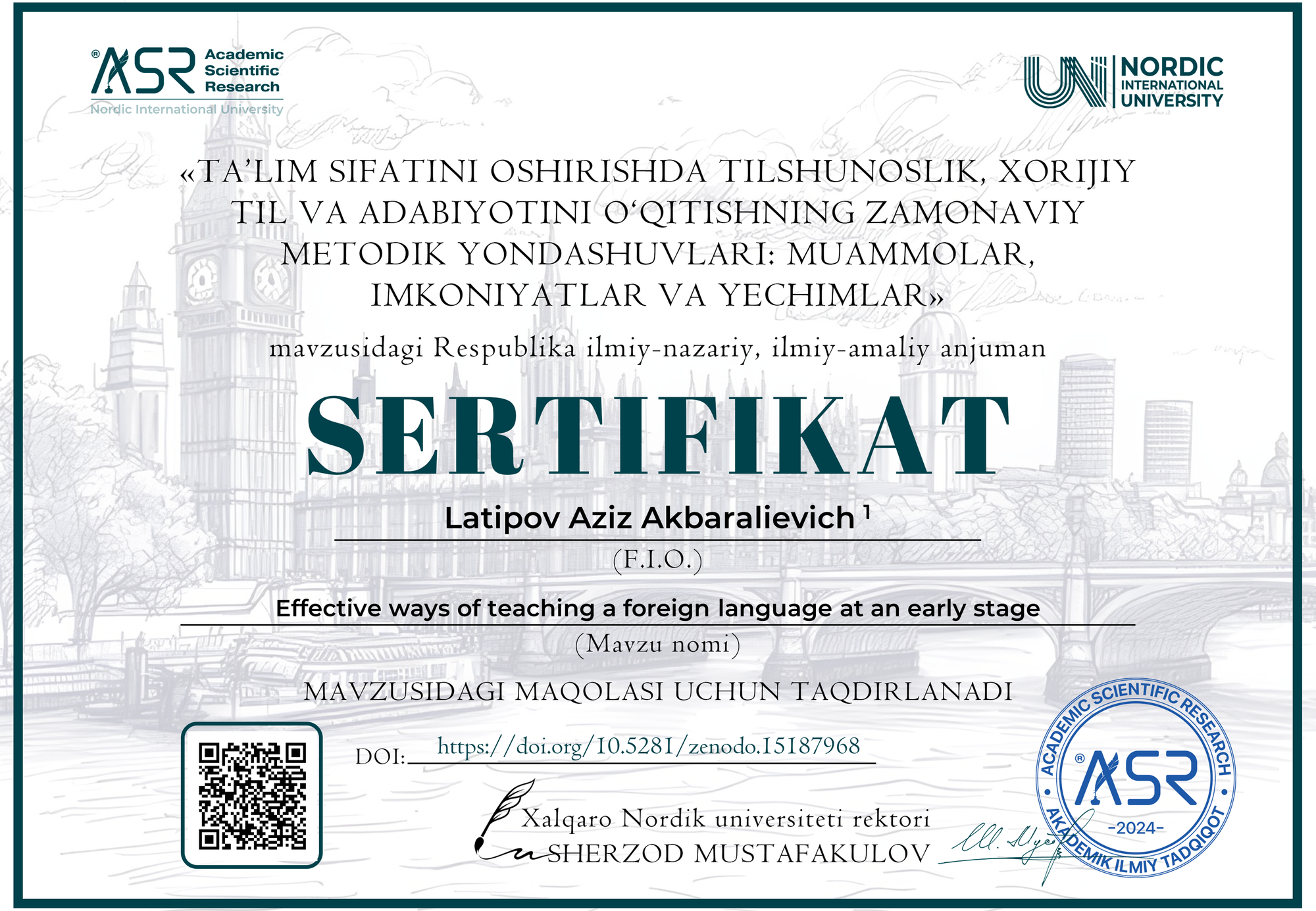Latipov Aziz Akbaralievich1

DOI: https://doi.org/10.5281/zenodo.15187968
Google scholar: https://scholar.google.com/scholar?hl=ru&as_sdt=0%2C5&q=%22EFFECTIVE+WAYS+OF+TEACHING+A+FOREIGN+LANGUAGE+AT+AN+EARLY+STAGE%22&btnG=
Zenodo community: https://zenodo.org/records/15187968
Nordic_press journal: https://research.nordicuniversity.org/index.php/nordic/article/view/2297
MAQOLANI YUKLAB OLISH
SERTIFIKATNI YUKLAB OLISH
REVIEW:
In this article, Dr. Aziz Akbaralievich Latipov delves into the significance and strategies of teaching foreign languages at an early stage of childhood development. Aimed at educators, this work emphasizes the importance of multilingual education, especially during the formative years between the ages of 5 to 10, when children exhibit their most receptive and adaptive cognitive abilities for language learning. The article provides a comprehensive review of the methods and challenges involved in early language instruction, highlighting the role of teachers in fostering a positive learning environment.
Summary of Key Points
Latipov focuses on the psychological and developmental characteristics of children during the critical period for language acquisition. The article stresses that children aged 5 to 10 are most capable of learning foreign languages effectively due to their developing cognitive skills such as attention span, memory, and logical thinking. The article also notes that during this period, children are more open to new experiences and have the necessary mental framework to absorb foreign language content.
A key theme in the article is the importance of cultivating a positive attitude towards learning foreign languages. Latipov outlines specific tasks for teachers, such as stimulating students' curiosity about new cultures, introducing them to foreign fairy tales and songs, and encouraging interactive play-based learning to improve communication skills. He argues that early exposure to foreign languages can lead to a natural acquisition of communication skills, which will be valuable in later stages of life.
Additionally, the article highlights the challenges associated with early language teaching, such as the potential for cognitive overload and the difficulties that arise when children are not sufficiently engaged. Latipov emphasizes the need for teachers to design lessons that are not only educational but also fun and engaging, integrating creative activities such as drawing, music, and crafts to maintain students' interest.
Strengths of the Article
Developmentally Informed Approach: One of the strongest points of the article is its focus on the cognitive and psychological development of children. The author bases his argument on sound developmental theories, ensuring that the strategies proposed align with the natural learning capabilities of young children.
Practical Teaching Methods: The article offers clear and practical suggestions for educators. The idea of integrating creative activities into language lessons, such as storytelling, songs, and play-based learning, is especially relevant and useful for teachers working with young children. This approach fosters a fun and dynamic learning environment.
Cultural Sensitivity: The emphasis on introducing children to the foreign culture through language, customs, and traditions is an important aspect of the article. This not only aids language acquisition but also helps to develop cross-cultural understanding from an early age.
Comprehensive Overview: The article is thorough in analyzing both the advantages and challenges of early language education. Latipov does not overlook the possible drawbacks, such as cognitive overload, fatigue, or lack of student motivation. He offers reasonable solutions to mitigate these issues, making the recommendations more practical and feasible.
Weaknesses of the Article
Overemphasis on Ideal Conditions: While the article provides an excellent overview of best practices, it tends to focus heavily on ideal conditions for teaching. In reality, factors such as a lack of resources, overcrowded classrooms, and differing levels of parental involvement can hinder the effective implementation of these strategies. A more nuanced discussion of how to adapt these strategies to challenging teaching environments could make the article more applicable in diverse settings.
Limited Focus on Technological Integration: The article does not delve into the potential benefits of integrating technology into early language learning. Given the increasing availability of digital learning tools, apps, and online resources, a more modern approach that includes technology could complement the strategies discussed and engage children more effectively.
Cultural Assumptions: While the article rightly emphasizes the introduction of foreign cultures, there could be more attention paid to the potential challenges or sensitivities in presenting a foreign culture to young learners. Children may come from diverse backgrounds, and some cultures may not always resonate with them, so more guidance on how to sensitively approach this aspect could be helpful.
Conclusion
Overall, Latipov's article provides a comprehensive and insightful analysis of early foreign language teaching, blending developmental psychology with practical strategies for educators. It effectively highlights the importance of early exposure to foreign languages and offers concrete methods for creating a positive and effective learning environment. While the article is certainly valuable for language educators, integrating a more diverse range of strategies, especially those involving technology and adapting to real-world constraints, would enhance its practical applicability. Nonetheless, it is a valuable resource for understanding the theory and practice of teaching foreign languages to young children and will undoubtedly aid teachers in designing more effective and engaging language lessons.



